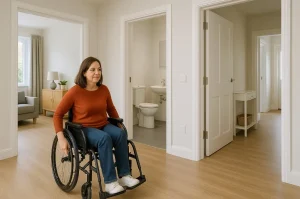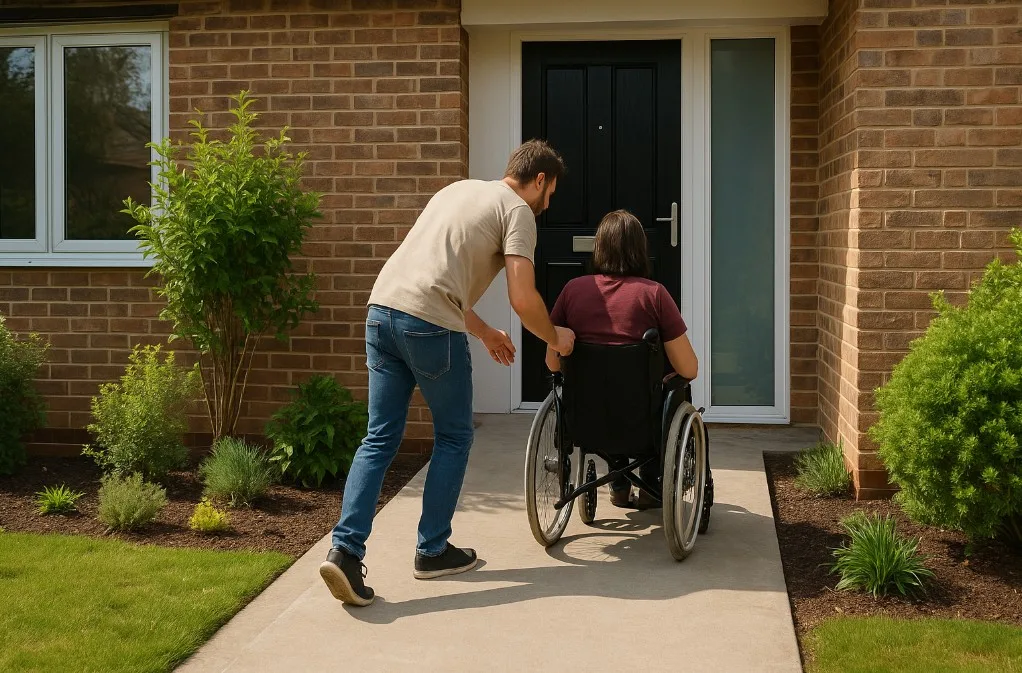Table of Contents
ToggleDo you or someone in your household live with a disability and wonder if this could reduce your council tax bill? Are you unsure which conditions qualify for exemptions, reductions, or discounts in the UK? For many families, council tax is a significant financial responsibility, and for households with disabled members, the additional costs of care, equipment, and home adaptations can make it even harder to manage.
The UK has schemes that recognise these challenges and aim to make council tax fairer. However, the eligibility rules can be confusing, especially since they depend on the type of disability, how it affects daily life, and whether the home has been adapted to meet specific needs.
This article explains in detail what disabilities qualify for council tax reduction, how different schemes work, and what steps you can take if you think you may be eligible.
What Does Council Tax Reduction for Disabilities Mean?

Council tax reduction for disabilities is financial relief provided to households where someone has a substantial and permanent disability. The purpose is to recognise that disabled individuals often require additional living space, facilities, or adaptations, which can result in higher living costs.
This reduction can apply whether the disabled person is the taxpayer or another resident of the property. It can be an adult or a child, and the essential point is that the disabled person must live in the property as their main home.
The system operates under two main frameworks: the Council Tax Reduction scheme, which is largely income-based, and the Disabled Band Reduction Scheme (DBRS), which specifically considers disability-related needs and adaptations in the home.
What is the Disabled Band Reduction Scheme?
The Disabled Band Reduction Scheme is a key part of disability-related council tax relief. It applies when a household occupies a property that is larger than they would otherwise require if no one living there was disabled. The scheme reduces the property’s council tax band by one level.
For example:
a home that would usually be charged at Band D would instead be billed at Band C. If a property is already in the lowest council tax band (Band A), the household receives a fixed reduction of 17% from their bill.
The scheme takes into account whether the property has been adapted in ways that are essential to meet the needs of the disabled person. These adaptations may include an additional bathroom or kitchen, a room used mainly for the disabled person, or sufficient indoor space for safe wheelchair use.
What Disabilities Qualify Under the Disabled Band Reduction Scheme?

A range of conditions may qualify, provided they require the home to be adapted or provide essential space. Examples include:
- Physical disabilities such as spinal cord injuries, muscular dystrophy, or cerebral palsy requiring wheelchair access indoors.
- Chronic health conditions like multiple sclerosis or severe arthritis requiring additional bathrooms or rest areas.
- Childhood disabilities where a child requires a therapy room or specialised living space.
The key factor is that the adaptations must be essential to the wellbeing of the disabled person, not just convenient.
How Do Severe Mental Impairments Affect Council Tax?
If someone in the household is classed as severely mentally impaired (SMI), further discounts or even full exemptions may apply.
Who is Considered Severely Mentally Impaired?
This term applies to people whose condition significantly limits their intelligence and social functioning. Examples include:
- Alzheimer’s disease
- Advanced dementia
- Severe learning difficulties
- Some long-term brain injuries
To qualify, the person must:
- Provide a medical certificate from a doctor confirming SMI.
- Be entitled to certain benefits such as Attendance Allowance, Personal Independence Payment (PIP), or Disability Living Allowance (DLA).
What Council Tax Discounts Apply for SMI?
- 100% exemption: If the person lives alone or only with other adults who are also severely mentally impaired or full-time students.
- 50% discount: If everyone else in the household is “disregarded” for council tax purposes.
- 25% discount: If the SMI person lives with one other qualifying adult and no one else counts.
Can Carers and Household Members Affect Eligibility?

Yes. The people who live with the disabled person can influence the level of discount applied to the property. For example, a household where a disabled person lives with a full-time carer may receive a 25% discount, provided the carer meets certain conditions. Carers must generally live in the property, provide at least 35 hours of care per week, and not be the spouse or partner of the disabled person.
Households where all adults are either severely mentally impaired, students, or carers may qualify for a much larger discount, in some cases up to 100%. This ensures that households providing care or support are not financially disadvantaged by council tax rules.
What Are the Qualifying Criteria for Disability-based Council Tax Reductions?
To qualify for council tax reductions linked to disability, the household must meet certain conditions:
- The disabled person must live in the property (adult or child).
- The disability must be substantial and permanent. This includes:
- Learning difficulties
- Mental health problems
- Physical disabilities
- The property must have one or more of the following:
- An extra bathroom or kitchen
- An extra room (not a bathroom or kitchen) used predominantly by the disabled person
- Enough floor space for safe indoor wheelchair use
In all cases, the adaptations must be considered necessary to meet the disabled person’s needs, not just for convenience.
How Can You Apply for a Council Tax Reduction for Disabilities?
The application process usually follows these steps:
- Check your eligibility on your local council’s website.
- Gather evidence, which may include:
- A doctor’s certificate confirming SMI or long-term disability.
- Proof of disability-related benefits such as PIP or DLA.
- Evidence of property adaptations.
- Complete and submit the application form (online, by post, or in person).
- Wait for the council’s decision, which typically takes 4–8 weeks.
If approved, reductions can sometimes be backdated to when the condition or adaptations first applied.
What Are Some Common Misconceptions About Council Tax Reductions?

There are several myths that often confuse households:
- Not every disability qualifies automatically. The council assesses applications based on medical evidence and home adaptations.
- The discount is not always means-tested. The Disabled Band Reduction Scheme is based on property needs, not income.
- Exemption and reduction are different. People with SMI may be exempt, while others may receive a reduction in their council tax band.
- Children can qualify. A child with a substantial and permanent disability can entitle the household to a reduction.
Table: Examples of Disabilities and Possible Council Tax Outcomes
| Disability or Condition | Possible Reduction or Exemption | Scheme Type |
| Alzheimer’s or advanced dementia | 100% exemption (if living alone) | Severe Mental Impairment |
| Wheelchair user with adapted home | Band reduction or 17% discount | Disabled Band Reduction Scheme |
| Child with cerebral palsy requiring therapy room | Band reduction | Disabled Band Reduction Scheme |
| Severe epilepsy with daily care needs | Discount if adaptations required | Disabled Band Reduction Scheme |
| Live-in carer for disabled relative | 25% discount | Carer Discount |
What Other Financial Support is Available Alongside Council Tax Reductions?
Disabled individuals may also be eligible for other forms of financial support, such as:
- Personal Independence Payment (PIP)
- Employment and Support Allowance (ESA)
- Attendance Allowance
- Carer’s Allowance
- Disabled Facilities Grants for home improvements
These benefits can often be claimed in addition to council tax support.
Conclusion
So, what disabilities qualify for council tax reduction? The answer depends on the nature of the disability, the adaptations in the home, and who else lives in the household. Severe mental impairments may lead to full exemptions, while substantial physical or learning disabilities can qualify for band reductions or discounts under the Disabled Band Reduction Scheme.
Applying may feel complex, but with the right evidence and a clear understanding of the rules, households across the UK can access vital financial relief.
FAQs
Does a child with disabilities count for council tax reduction?
Yes. If a child lives in the home and requires extra space or facilities, the household can apply under the Disabled Band Reduction Scheme.
Do temporary conditions qualify for council tax reductions?
No. The disability must be substantial and permanent, not a short-term illness or recovery.
Can more than one disabled person in a home increase the discount?
Yes. If multiple residents meet the criteria, the household may qualify for larger reductions or even exemption.
Do I need to be receiving disability benefits to qualify?
Not always. For the Disabled Band Reduction Scheme, the key requirement is home adaptations, not benefits. For SMI discounts, however, proof of benefits is often required.
How much is the reduction worth?
It depends:
- Band reduction (one level down)
- 17% discount if already in Band A
- Up to 100% exemption for severe mental impairment
Can carers also get a discount?
Yes. If a live-in carer supports a disabled person and meets the criteria, a 25% reduction may apply.
Will the council backdate my reduction?
In some cases, yes. Councils may backdate to when the disability or home adaptation first applied




